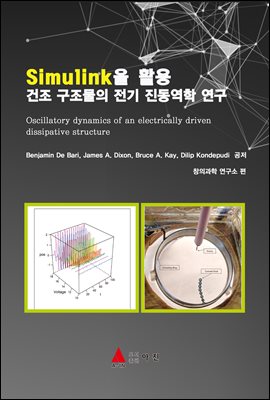
Simulink을 활용 건조 구조물의 전기 진동역학 연구
- 저자Benjamin De Bari, James A. Dixon, Bruce A. Kay, Dilip Kondepudi 저
- 출판사아진
- 출판일2020-07-13
- 등록일2020-12-21
- SNS공유


- 파일포맷PDF
- 파일크기12MB
- 공급사YES24
-
지원기기
PC
PHONE
TABLET
프로그램 수동설치
전자책 프로그램 수동설치 안내
아이폰, 아이패드, 안드로이드폰, 태블릿,
보유 1, 대출 0,
예약 0, 누적대출 8, 누적예약 0
책소개
Physical systems open to a flow of energy can exhibit spontaneous symmetrybreaking and self-organization. These nonequilibrium self-organized systems are
known as dissipative structures. We study the oscillatory mode of an electrically
driven dissipative structure. Our system consists of aluminum beads in shallow oil,
which, when subjected to a high voltage, self-organize into connected ‘tree’
structures. The tree structures serve as pathways for the conduction of charge to
ground. This system shows a variety of spatio-temporal behaviors, such as
oscillating movement of the tree structures. Utilizing a dynamical systems model of
the electromagnetic phenomena, we explore a potential mechanism underlying the
system’s behavior and use the model to make additional empirical predictions.
The model reproduces the oscillatory behavior observed in the real system, and the
behavior of the real system is consistent with predictions from the model under
various constraints. From the empirical results and the mathematical model, we
observe a tendency for the system to select modes of behavior with increased
dissipation, or higher rates of entropy production, in accord with the proposed
Maximum Entropy Production (MEP) Principle.
목차
제 1편 : SIMULINK 기본편1.1 SIMULINK의 시작 1
블록의 연결 5
블록 파라미터의 설정 7
시뮬레이션 파라미터 (Configuration Parameters)의 설정 8
시뮬레이션의 수행 9
블록 파라미터의 표시 9
복수 데이터의 표시 11
2.2 동적 시뮬레이션 13
이차 미분방정식 17
선형 상태변수 모델 23
DC 모터의 시뮬레이션 24
함수 블록의 사용 29
차분방정식(difference equation)의 모델링 34
Subsystem(부시스템)의 구성 37
제 2편 : 연구논문
Oscillatory dynamics of an electrically driven dissipative structure
1. Electrical self-organized Foraging Implementation 42
2. The charge-depletion model (CDM) 44
3. Materials and methods 48
4. Results 50
5. Stability analysis 53
6. Discussion 55
7. Conclusions 58
8. References 61

















